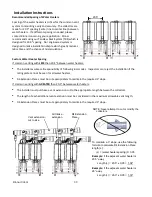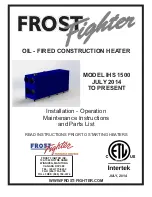
Rinnai CVent
16
Venting Guidelines
DO NOT
Do not install in separate distribution systems. All
water heaters common vented must be in the
same hot and cold plumbing manifolds and must
not exceed 8 units.
Do not use PVC, CPVC, ABS or galvanized material
for the exhaust vent. CVent must utilize PPTL or
PPS on the exhaust side of the system.
Do not combine vent components from different
manufacturers.
Vent diameter must not be reduced.
Do not connect the venting system with an
existing vent or chimney.
Do not common vent with the vent pipe of any
other type of water heater or appliance.
Do not install the water heater in an area of
negative pressure.
Do not install the water heater, venting, and vent
termination(s) in any areas where the air may
contain corrosive compounds.
MUST DO
•
The water heater dip switch setting must always
be set to long vent (SW1 in DIPSW1 should be set
to OFF position).
You must use vent components that are certified
and listed with the water heater model.
The vent system must vent directly to the outside
of the building and use outside air or room air
(room air is for C199i commercial water heater
applications only)
for combustion.
Avoid dips or sags in horizontal vent runs by
installing supports per the vent manufacturer’s
instructions.
Support horizontal vent runs a minimum of every
four feet and all vertical vent runs a minimum of
every six feet.
Venting should be as direct as possible with a
minimum number of pipe fittings.
Vent connections must be firmly pressed together
so that the gaskets form an air tight seal.
Install an appliance adapter which contains a
check valve onto each water heater. Use only the
check valve specified in this manual. Do not
attempt to build your own system.
The air intake appliance adapter connected to the
water heater must be secured with one self-
tapping screw.
Check and clean the header check valve every 12
months according to the maintenance instructions
in this manual.
Set the temperature setting on all water heaters
being common vented to the same temperature.
INFORMATION
Unless recovering a tank, Rinnai recommends
installing an MSB controller when common
venting and where water heaters are in a manifold
system.
For assembly details, refer to the Ubbink
Installation and Assembly Instructions located in
the appendix of this manual.
Rinnai recommends replacing the check valve
when replacing the water heater.
The Ubbink Polypropylene Translucent (PPTL for U.S. Applications) and/or Polypropylene S
(PPS for Canadian Applications)
CVent can be used on both the combustion air and exhaust. Field supplied PVC material
can only be used on the combustion air side and
MUST NOT
be used for the exhaust. For
Canadian installation, all materials must be ULC-S636 approved.
WARNING
Summary of Contents for c199i
Page 43: ...43 Rinnai CVent NOTES ...
Page 86: ...86 CVent de Rinnai NOTES ...
Page 87: ...87 CVent de Rinnai NOTES ...
















































